Recommendations to Reduce Multicultural Tension in a Global Company
VerifiedAdded on 2020/03/28
|5
|1074
|92
Report
AI Summary
This report focuses on strategies to reduce multicultural tension within a global company operating in diverse cultural contexts. It defines multicultural tension as arising from differing cultural beliefs and practices among employees from various nations, which can lead to issues like high turnover and low morale. The report recommends that the company research the cultural contexts of the nations it collaborates with, respect foreign cultures, build strong relationships between managers and employees, establish single and neutral work ethics, and encourage employee participation in cultural events. The overall goal is to prevent conflicts, foster integration, and create a more harmonious and productive workplace. The report also references several academic sources to support its recommendations.
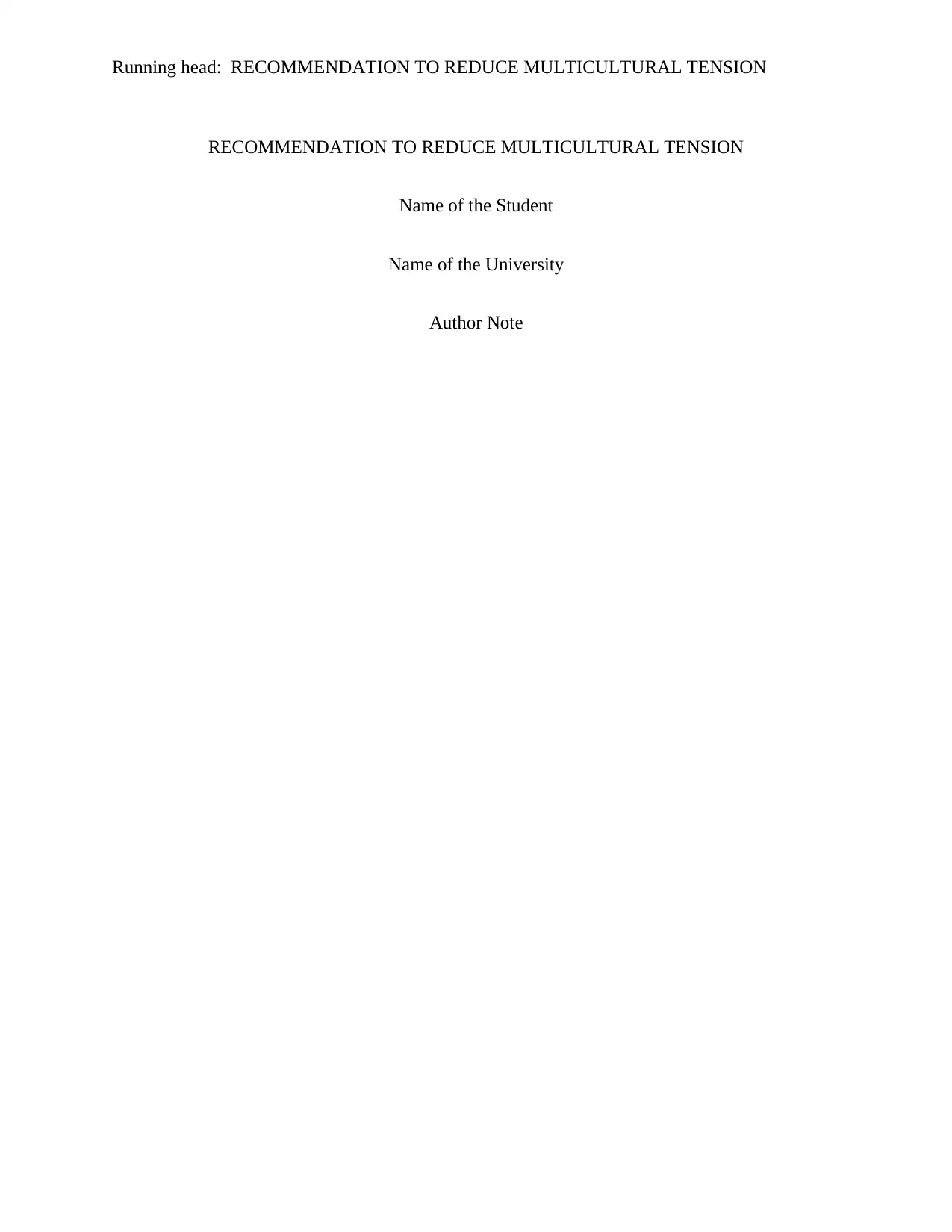
Running head: RECOMMENDATION TO REDUCE MULTICULTURAL TENSION
RECOMMENDATION TO REDUCE MULTICULTURAL TENSION
Name of the Student
Name of the University
Author Note
RECOMMENDATION TO REDUCE MULTICULTURAL TENSION
Name of the Student
Name of the University
Author Note
Paraphrase This Document
Need a fresh take? Get an instant paraphrase of this document with our AI Paraphraser
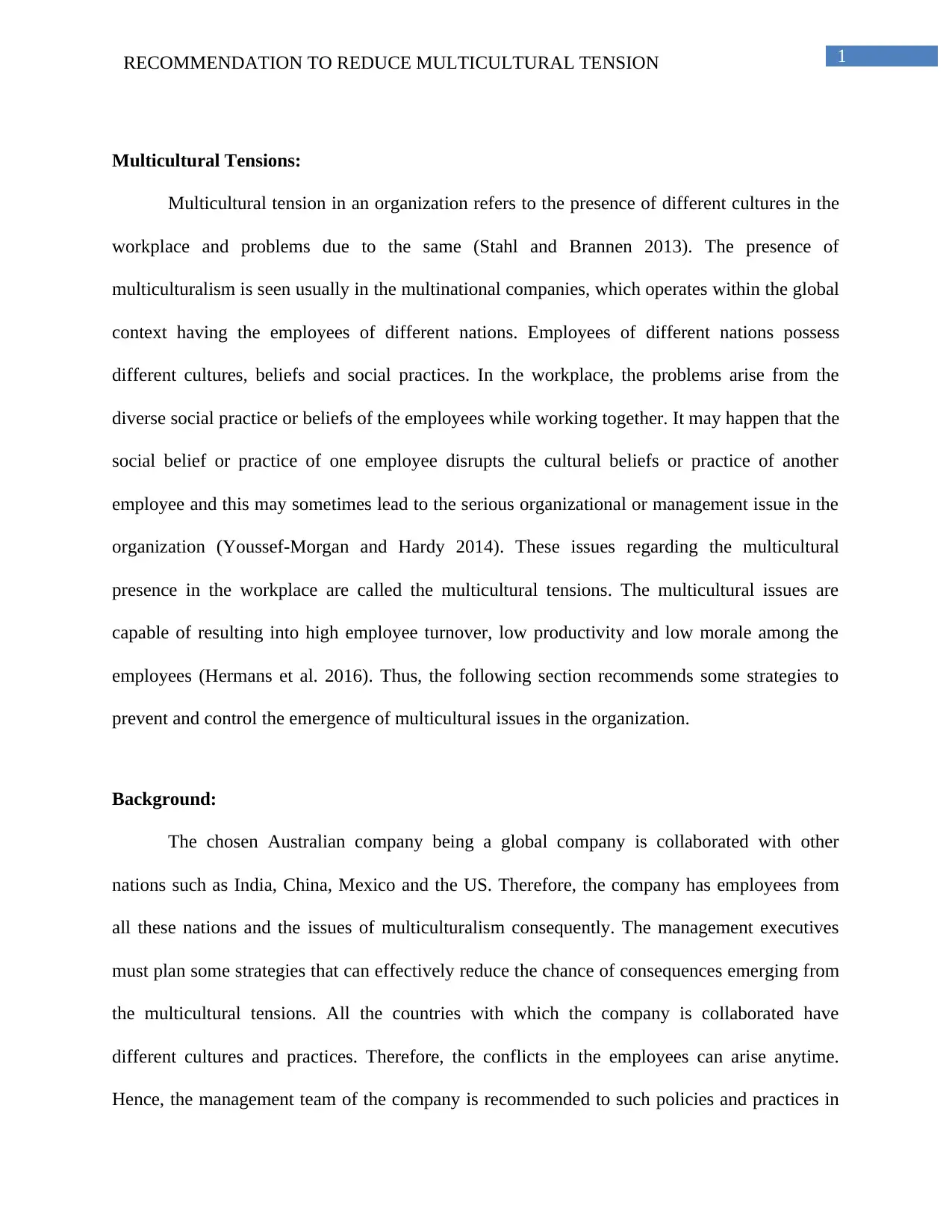
1RECOMMENDATION TO REDUCE MULTICULTURAL TENSION
Multicultural Tensions:
Multicultural tension in an organization refers to the presence of different cultures in the
workplace and problems due to the same (Stahl and Brannen 2013). The presence of
multiculturalism is seen usually in the multinational companies, which operates within the global
context having the employees of different nations. Employees of different nations possess
different cultures, beliefs and social practices. In the workplace, the problems arise from the
diverse social practice or beliefs of the employees while working together. It may happen that the
social belief or practice of one employee disrupts the cultural beliefs or practice of another
employee and this may sometimes lead to the serious organizational or management issue in the
organization (Youssef-Morgan and Hardy 2014). These issues regarding the multicultural
presence in the workplace are called the multicultural tensions. The multicultural issues are
capable of resulting into high employee turnover, low productivity and low morale among the
employees (Hermans et al. 2016). Thus, the following section recommends some strategies to
prevent and control the emergence of multicultural issues in the organization.
Background:
The chosen Australian company being a global company is collaborated with other
nations such as India, China, Mexico and the US. Therefore, the company has employees from
all these nations and the issues of multiculturalism consequently. The management executives
must plan some strategies that can effectively reduce the chance of consequences emerging from
the multicultural tensions. All the countries with which the company is collaborated have
different cultures and practices. Therefore, the conflicts in the employees can arise anytime.
Hence, the management team of the company is recommended to such policies and practices in
Multicultural Tensions:
Multicultural tension in an organization refers to the presence of different cultures in the
workplace and problems due to the same (Stahl and Brannen 2013). The presence of
multiculturalism is seen usually in the multinational companies, which operates within the global
context having the employees of different nations. Employees of different nations possess
different cultures, beliefs and social practices. In the workplace, the problems arise from the
diverse social practice or beliefs of the employees while working together. It may happen that the
social belief or practice of one employee disrupts the cultural beliefs or practice of another
employee and this may sometimes lead to the serious organizational or management issue in the
organization (Youssef-Morgan and Hardy 2014). These issues regarding the multicultural
presence in the workplace are called the multicultural tensions. The multicultural issues are
capable of resulting into high employee turnover, low productivity and low morale among the
employees (Hermans et al. 2016). Thus, the following section recommends some strategies to
prevent and control the emergence of multicultural issues in the organization.
Background:
The chosen Australian company being a global company is collaborated with other
nations such as India, China, Mexico and the US. Therefore, the company has employees from
all these nations and the issues of multiculturalism consequently. The management executives
must plan some strategies that can effectively reduce the chance of consequences emerging from
the multicultural tensions. All the countries with which the company is collaborated have
different cultures and practices. Therefore, the conflicts in the employees can arise anytime.
Hence, the management team of the company is recommended to such policies and practices in
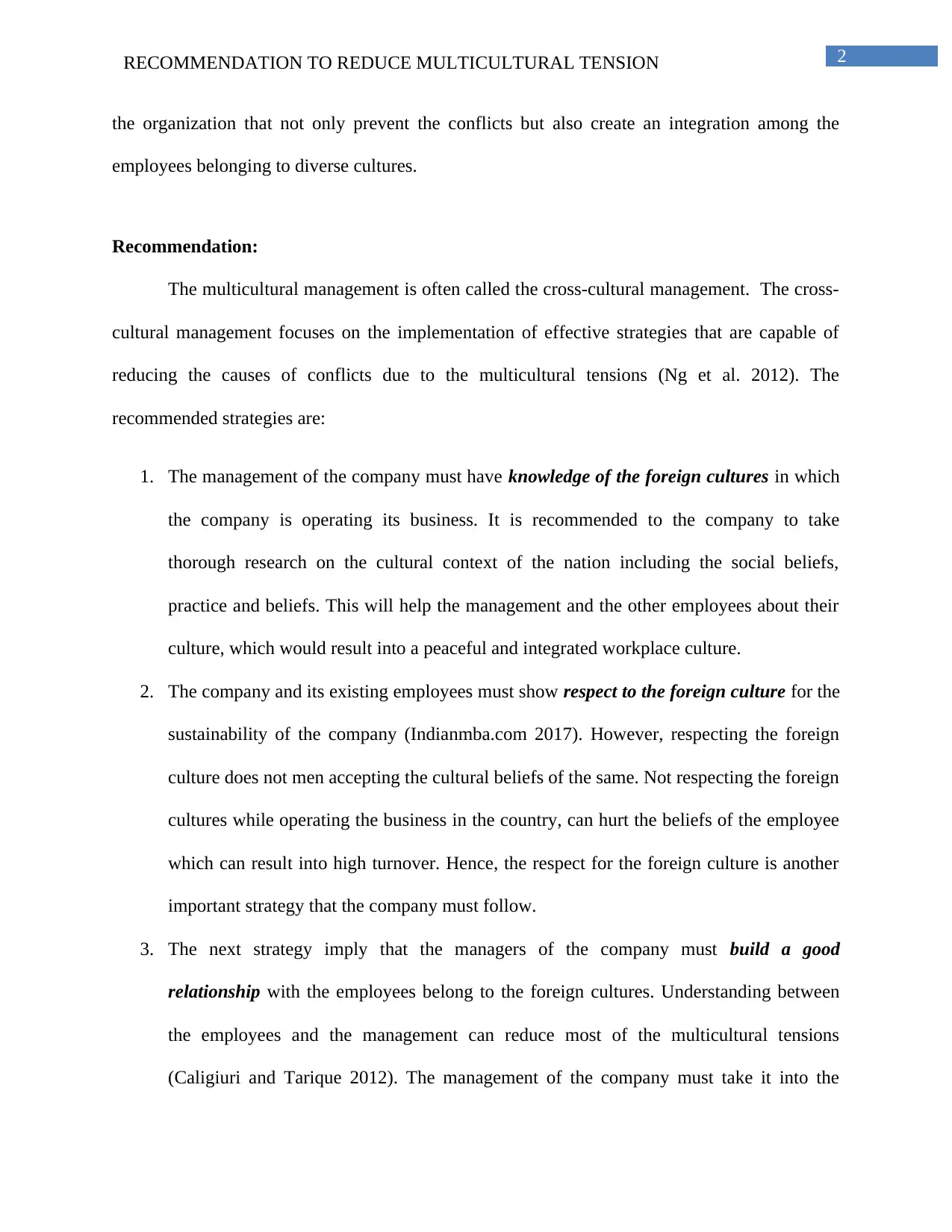
2RECOMMENDATION TO REDUCE MULTICULTURAL TENSION
the organization that not only prevent the conflicts but also create an integration among the
employees belonging to diverse cultures.
Recommendation:
The multicultural management is often called the cross-cultural management. The cross-
cultural management focuses on the implementation of effective strategies that are capable of
reducing the causes of conflicts due to the multicultural tensions (Ng et al. 2012). The
recommended strategies are:
1. The management of the company must have knowledge of the foreign cultures in which
the company is operating its business. It is recommended to the company to take
thorough research on the cultural context of the nation including the social beliefs,
practice and beliefs. This will help the management and the other employees about their
culture, which would result into a peaceful and integrated workplace culture.
2. The company and its existing employees must show respect to the foreign culture for the
sustainability of the company (Indianmba.com 2017). However, respecting the foreign
culture does not men accepting the cultural beliefs of the same. Not respecting the foreign
cultures while operating the business in the country, can hurt the beliefs of the employee
which can result into high turnover. Hence, the respect for the foreign culture is another
important strategy that the company must follow.
3. The next strategy imply that the managers of the company must build a good
relationship with the employees belong to the foreign cultures. Understanding between
the employees and the management can reduce most of the multicultural tensions
(Caligiuri and Tarique 2012). The management of the company must take it into the
the organization that not only prevent the conflicts but also create an integration among the
employees belonging to diverse cultures.
Recommendation:
The multicultural management is often called the cross-cultural management. The cross-
cultural management focuses on the implementation of effective strategies that are capable of
reducing the causes of conflicts due to the multicultural tensions (Ng et al. 2012). The
recommended strategies are:
1. The management of the company must have knowledge of the foreign cultures in which
the company is operating its business. It is recommended to the company to take
thorough research on the cultural context of the nation including the social beliefs,
practice and beliefs. This will help the management and the other employees about their
culture, which would result into a peaceful and integrated workplace culture.
2. The company and its existing employees must show respect to the foreign culture for the
sustainability of the company (Indianmba.com 2017). However, respecting the foreign
culture does not men accepting the cultural beliefs of the same. Not respecting the foreign
cultures while operating the business in the country, can hurt the beliefs of the employee
which can result into high turnover. Hence, the respect for the foreign culture is another
important strategy that the company must follow.
3. The next strategy imply that the managers of the company must build a good
relationship with the employees belong to the foreign cultures. Understanding between
the employees and the management can reduce most of the multicultural tensions
(Caligiuri and Tarique 2012). The management of the company must take it into the
⊘ This is a preview!⊘
Do you want full access?
Subscribe today to unlock all pages.

Trusted by 1+ million students worldwide
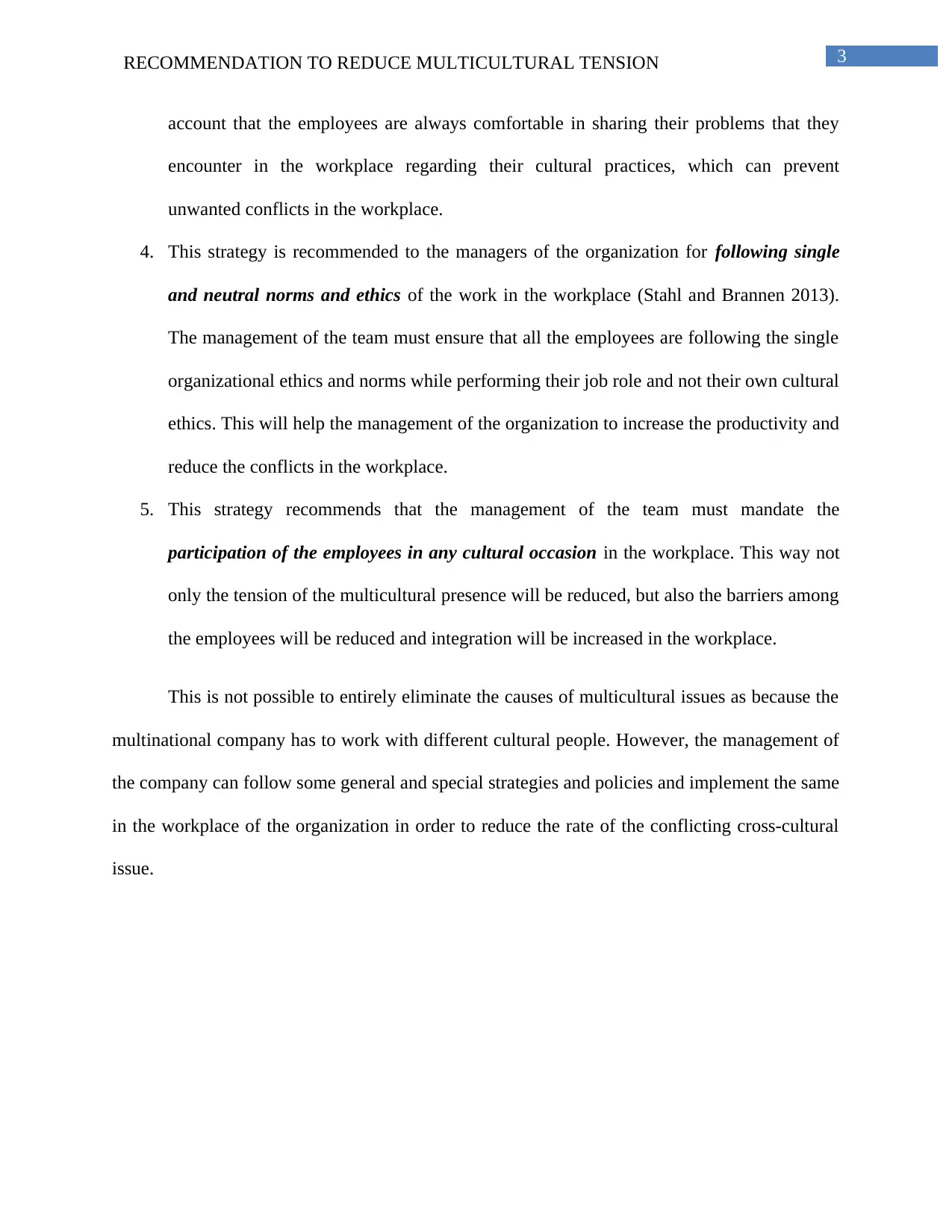
3RECOMMENDATION TO REDUCE MULTICULTURAL TENSION
account that the employees are always comfortable in sharing their problems that they
encounter in the workplace regarding their cultural practices, which can prevent
unwanted conflicts in the workplace.
4. This strategy is recommended to the managers of the organization for following single
and neutral norms and ethics of the work in the workplace (Stahl and Brannen 2013).
The management of the team must ensure that all the employees are following the single
organizational ethics and norms while performing their job role and not their own cultural
ethics. This will help the management of the organization to increase the productivity and
reduce the conflicts in the workplace.
5. This strategy recommends that the management of the team must mandate the
participation of the employees in any cultural occasion in the workplace. This way not
only the tension of the multicultural presence will be reduced, but also the barriers among
the employees will be reduced and integration will be increased in the workplace.
This is not possible to entirely eliminate the causes of multicultural issues as because the
multinational company has to work with different cultural people. However, the management of
the company can follow some general and special strategies and policies and implement the same
in the workplace of the organization in order to reduce the rate of the conflicting cross-cultural
issue.
account that the employees are always comfortable in sharing their problems that they
encounter in the workplace regarding their cultural practices, which can prevent
unwanted conflicts in the workplace.
4. This strategy is recommended to the managers of the organization for following single
and neutral norms and ethics of the work in the workplace (Stahl and Brannen 2013).
The management of the team must ensure that all the employees are following the single
organizational ethics and norms while performing their job role and not their own cultural
ethics. This will help the management of the organization to increase the productivity and
reduce the conflicts in the workplace.
5. This strategy recommends that the management of the team must mandate the
participation of the employees in any cultural occasion in the workplace. This way not
only the tension of the multicultural presence will be reduced, but also the barriers among
the employees will be reduced and integration will be increased in the workplace.
This is not possible to entirely eliminate the causes of multicultural issues as because the
multinational company has to work with different cultural people. However, the management of
the company can follow some general and special strategies and policies and implement the same
in the workplace of the organization in order to reduce the rate of the conflicting cross-cultural
issue.
Paraphrase This Document
Need a fresh take? Get an instant paraphrase of this document with our AI Paraphraser
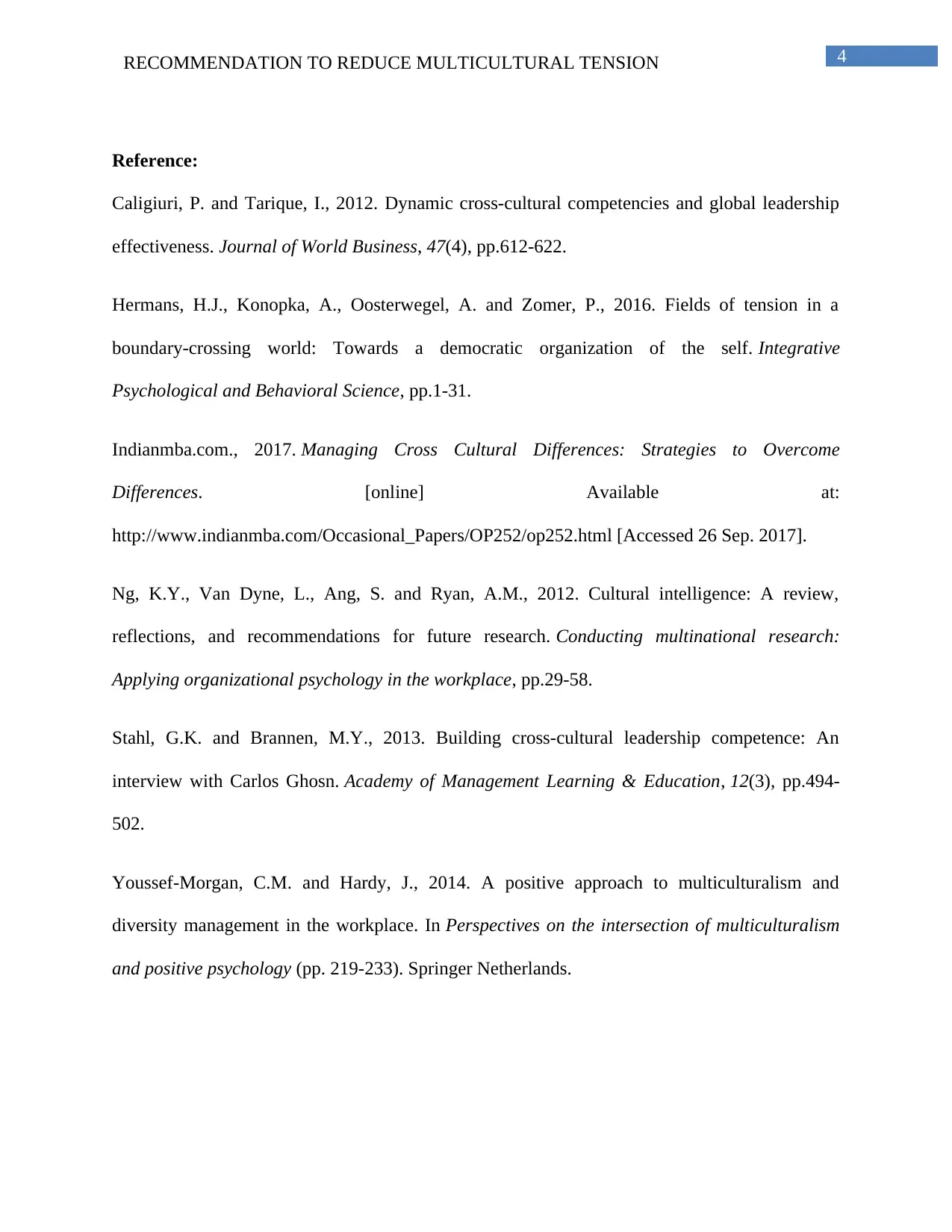
4RECOMMENDATION TO REDUCE MULTICULTURAL TENSION
Reference:
Caligiuri, P. and Tarique, I., 2012. Dynamic cross-cultural competencies and global leadership
effectiveness. Journal of World Business, 47(4), pp.612-622.
Hermans, H.J., Konopka, A., Oosterwegel, A. and Zomer, P., 2016. Fields of tension in a
boundary-crossing world: Towards a democratic organization of the self. Integrative
Psychological and Behavioral Science, pp.1-31.
Indianmba.com., 2017. Managing Cross Cultural Differences: Strategies to Overcome
Differences. [online] Available at:
http://www.indianmba.com/Occasional_Papers/OP252/op252.html [Accessed 26 Sep. 2017].
Ng, K.Y., Van Dyne, L., Ang, S. and Ryan, A.M., 2012. Cultural intelligence: A review,
reflections, and recommendations for future research. Conducting multinational research:
Applying organizational psychology in the workplace, pp.29-58.
Stahl, G.K. and Brannen, M.Y., 2013. Building cross-cultural leadership competence: An
interview with Carlos Ghosn. Academy of Management Learning & Education, 12(3), pp.494-
502.
Youssef-Morgan, C.M. and Hardy, J., 2014. A positive approach to multiculturalism and
diversity management in the workplace. In Perspectives on the intersection of multiculturalism
and positive psychology (pp. 219-233). Springer Netherlands.
Reference:
Caligiuri, P. and Tarique, I., 2012. Dynamic cross-cultural competencies and global leadership
effectiveness. Journal of World Business, 47(4), pp.612-622.
Hermans, H.J., Konopka, A., Oosterwegel, A. and Zomer, P., 2016. Fields of tension in a
boundary-crossing world: Towards a democratic organization of the self. Integrative
Psychological and Behavioral Science, pp.1-31.
Indianmba.com., 2017. Managing Cross Cultural Differences: Strategies to Overcome
Differences. [online] Available at:
http://www.indianmba.com/Occasional_Papers/OP252/op252.html [Accessed 26 Sep. 2017].
Ng, K.Y., Van Dyne, L., Ang, S. and Ryan, A.M., 2012. Cultural intelligence: A review,
reflections, and recommendations for future research. Conducting multinational research:
Applying organizational psychology in the workplace, pp.29-58.
Stahl, G.K. and Brannen, M.Y., 2013. Building cross-cultural leadership competence: An
interview with Carlos Ghosn. Academy of Management Learning & Education, 12(3), pp.494-
502.
Youssef-Morgan, C.M. and Hardy, J., 2014. A positive approach to multiculturalism and
diversity management in the workplace. In Perspectives on the intersection of multiculturalism
and positive psychology (pp. 219-233). Springer Netherlands.
1 out of 5
Related Documents
Your All-in-One AI-Powered Toolkit for Academic Success.
+13062052269
info@desklib.com
Available 24*7 on WhatsApp / Email
![[object Object]](/_next/static/media/star-bottom.7253800d.svg)
Unlock your academic potential
Copyright © 2020–2025 A2Z Services. All Rights Reserved. Developed and managed by ZUCOL.





